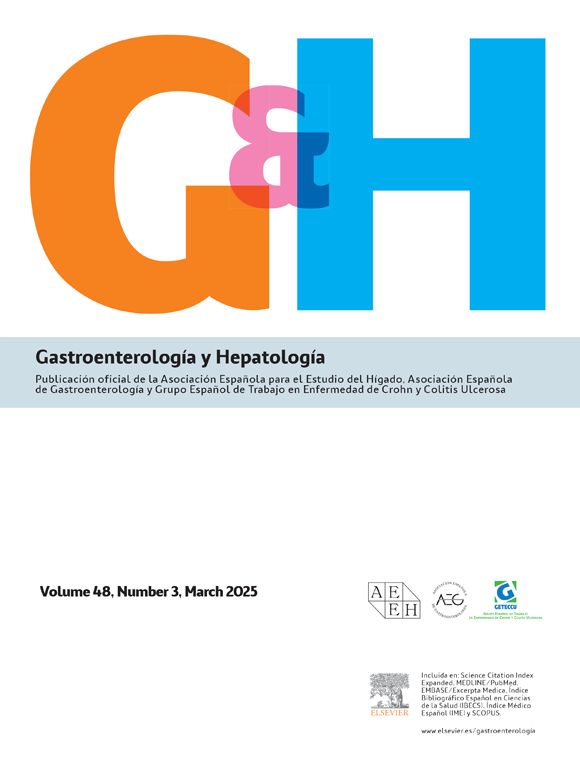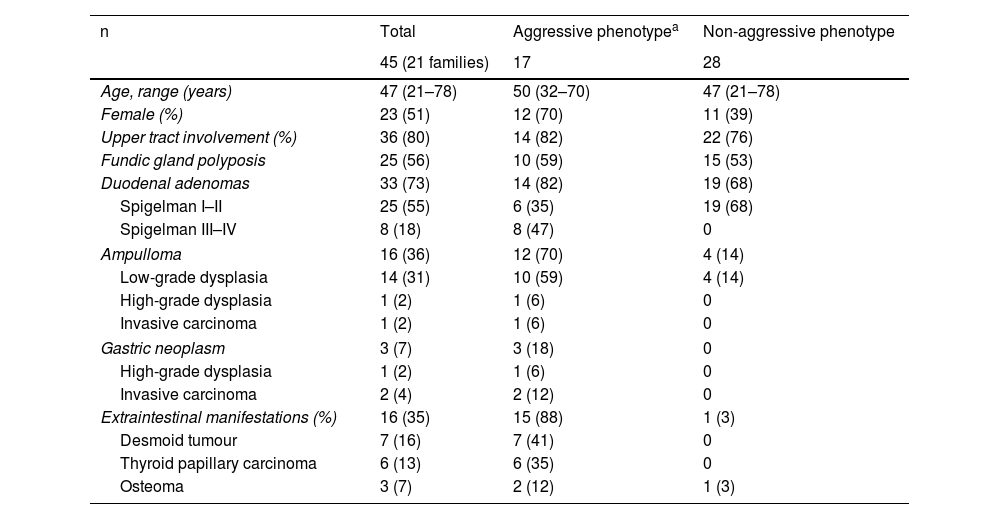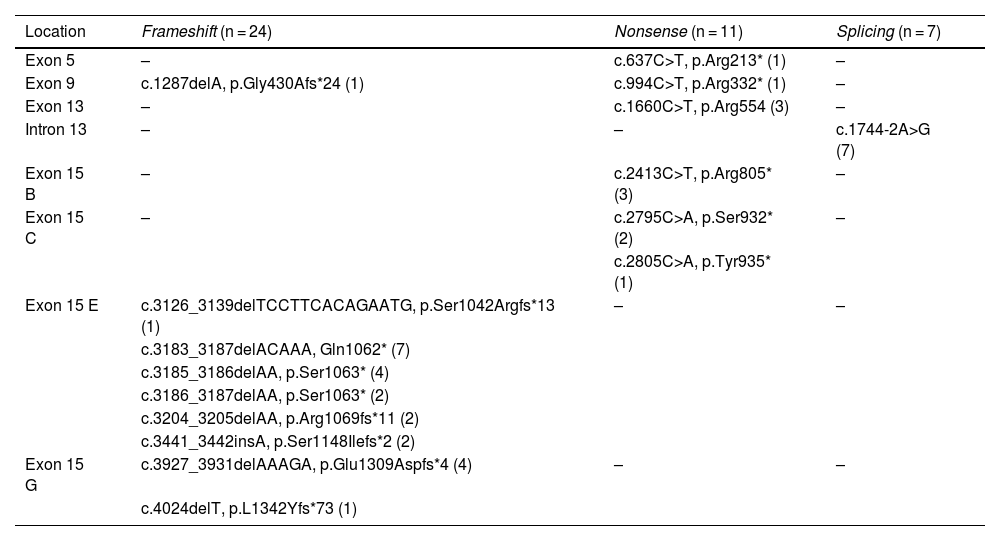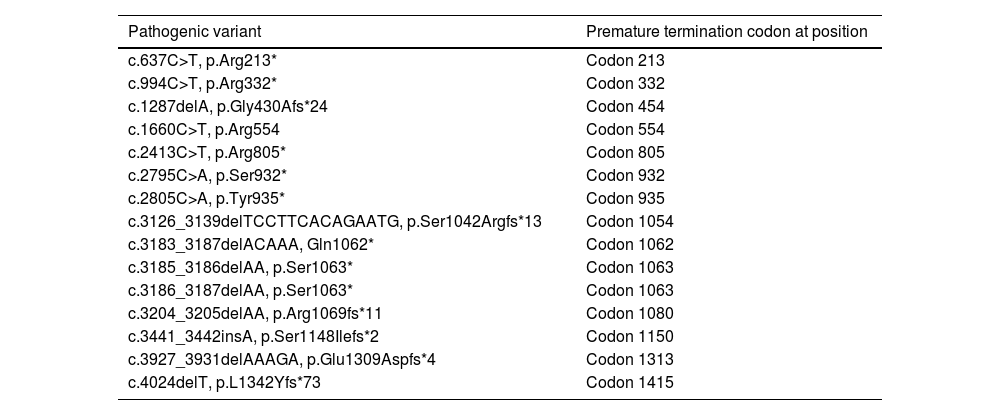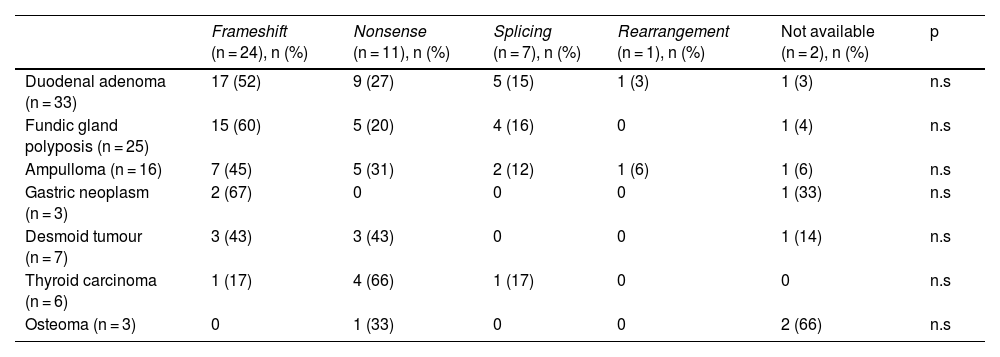Familial adenomatous polyposis (FAP) is a hereditary disease caused by mutations in the APC gene, which is also associated with extracolonic manifestations. The objective was to characterize the extracolonic manifestations in a cohort of patients with classic FAP and the possible genotype-phenotype association.
Materials and methodsThe study design was observational and descriptive. Demographic, clinical, and genetic variables were collected based on the type of mutation (frameshift, nonsense, splicing, rearrangement, and others).
ResultsWe included 45 patients with FAP (mean age 47 years, range 21–78; 51% female), belonging to 21 families, with a median of 2 (range 0–6) manifestations per patient. Eighty percent (n = 36) had upper digestive tract involvement, with duodenal adenomas (73%), fundic gland polyposis (56%), and ampullary adenoma (36%) being the most frequent findings. The most common extraintestinal manifestations were desmoid tumors (16%) and papillary thyroid carcinoma (13%). Thirty eight percent of the patients presented an aggressive phenotype (Spigelman III–IV, high-grade dysplasia, invasive neoplasia, desmoid tumor, and papillary thyroid carcinoma). The most common genetic mutations were frameshift (56%), nonsense (26%), and splicing (16%), primarily located in exon 15 (50%). No significant correlation was found between the type of genetic mutation and the severity or location of phenotypic manifestations.
ConclusionsOne-third of patients with FAP present an aggressive phenotype, without a demonstrated correlation between the type of genetic alteration and the phenotypic manifestations.
La poliposis adenomatosa familiar (PAF) es una enfermedad hereditaria causada por variantes patogénicas del gen APC, que también se asocia con manifestaciones extracolónicas. El objetivo fue caracterizar las manifestaciones extracolónicas en una cohorte de pacientes con PAF clásica y la posible asociación genotipo-fenotipo.
Materiales y métodosEl diseño del estudio fue observacional descriptivo. Se recogieron las variables demográficas, clínicas y genéticas en función del tipo de variante patogénica (frameshift, nonsense, splicing, rearrangement y otras).
ResultadosSe incluyeron 45 pacientes con PAF (edad media 47 años, rango 21–78; sexo femenino 51%), pertenecientes a 21 familias, con una mediana de 2 (rango 0–6) manifestaciones por paciente. El 80% (n = 36) presentaron afectación del tracto digestivo superior, siendo los adenomas duodenales (73%), la poliposis fúndica (56%) y la presencia de ampuloma (36%) los hallazgos más frecuentes. Las afectaciones extraintestinales más frecuentes fueron el tumor desmoide (16%) y el carcinoma papilar de tiroides (13%). El 38% de los pacientes presentaron un fenotipo agresivo (Spigelman III-IV, displasia de alto grado, neoplasia invasiva, tumor desmoide y carcinoma papilar de tiroides). Las variantes patogénicas más habituales fueron frameshift (56%), nonsense (26%) y splicing (16%), localizadas principalmente en el exón 15 (50%). No se demostró una correlación significativa entre el tipo de variante patogénica con la gravedad y la localización de las manifestaciones fenotípicas.
ConclusionesUna tercera parte de los pacientes con PAF presentan un fenotipo agresivo, sin demostrarse una correlación entre el tipo de alteración genética y las manifestaciones fenotípicas.




